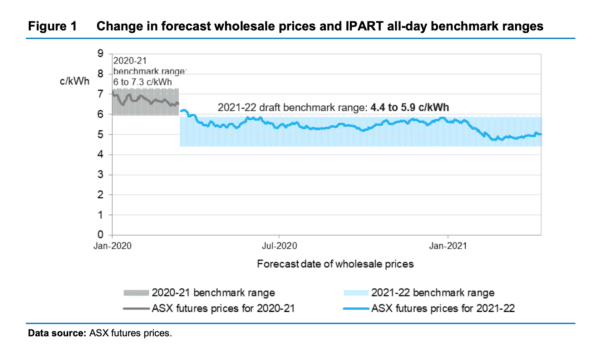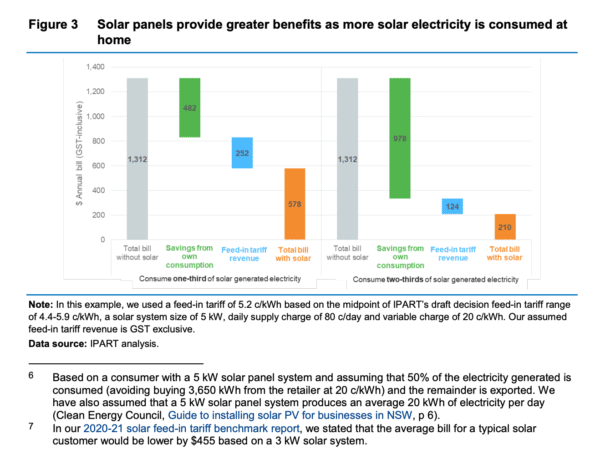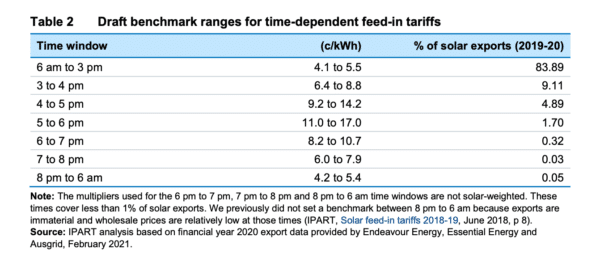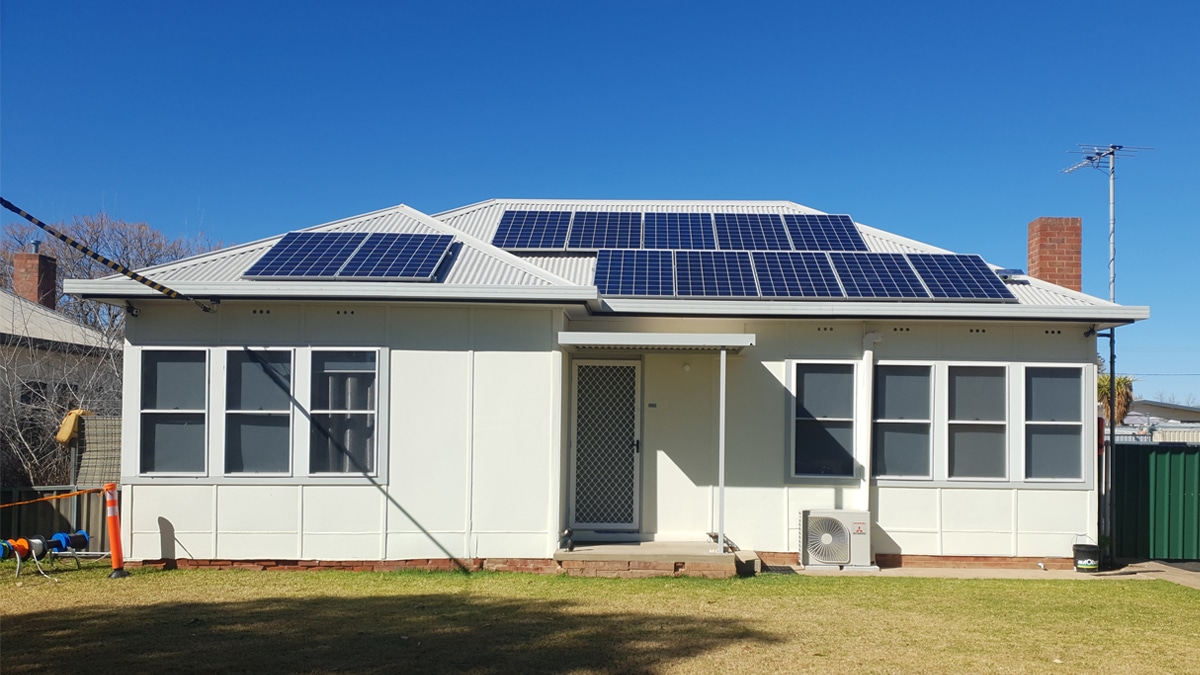All-day solar feed-in tariffs (FiTs) in New South Wales are set to fall according to draft recommendations of the state’s Independent Pricing and Regulatory Tribunal (IPART) released last week. The proposed addition of time-of-day FiTs will see the benefits shift towards households and businesses that also have battery storage, and who generate enough excess electricity to export to the grid during the evening peak electricity-demand period.
The current all-day benchmark range for 2020-2021 is 6.0 to 7.3 cents/kilowatt hour; the draft decision for 2021-2022 is to reduce that range to 4.4 to 5.9 c/kWh.
Introduction of a time-of-day structure could see exports from 3pm to 4pm priced at 6.4-8.8 c/kWh and from 5pm to 6pm increase up to 17 c/kWh, when solar irradiance is typically low — favouring the battery brave.
“Our draft guide is lower than the most recent years due to decreasing electricity prices,” said Tribunal member, and contributor to the IPART report, Sandra Gamble.
It makes sense that FiTs will follow the trends in wholesale prices for electricity, and IPART is basing its recommendations to energy retailers on forecasts that wholesale electricity prices will continue on a downward trajectory, caused largely by an increase in the supply of renewable energy generated by around 500,000 NSW households and small businesses with rooftop solar installed.

Falling tariffs meet AEMC solar tax …
But this IPART recommendation, which retailers are not obliged to take into account, comes on the heels of a draft determination by the Australian Energy Market Commission that network operators would impose charges on rooftop solar exported to the grid, in order to incentivise PV-enabled premises to self-consume more of their generated energy — another development that will favour battery uptake.
This is expected to avoid overloading grid capabilities at peak times which is leading to caps on the size of system allowed to connect to the grid in some areas, or to new customers being limited to zero-export solar options.
“Doing nothing is not an option because blocking people’s power exports will cost them now and more in future”, argued Ben Barr, Chief Executive of the AEMC when the determination was issued in March. He added, “While export charges on a 4−6 kW system might lead to a marginal drop in solar earnings, owners will face that same drop if they are constrained from exporting energy just 10% of the time.”
The draft determination was quickly branded a “solar tax”, with industry players saying it will penalise those who have invested in solar, by skimming off some of the income they make from exports, ostensibly to help fund network upgrades needed to enable two-way flow of energy and allow more solar into the grid.
Heavy on regulation, low on detail
The solar industry’s concerns with this proposal are many, with the Clean Energy Council immediately responding to draft saying it raised more questions than answers. Among them: Whether such a scheme would be mandatory; whether export charges would be applied to all customers; whether zero export limits would continue to be imposed; whether ombudsmen would be appointed to intervene on solar customers’ complaints; and whether distribution networks would be required to fix poor voltage management before or after the reforms come into effect.
The Community group Solar Citizens said at the time, “The notion that big energy companies will do the right thing by their customers is fanciful.”
In terms of income reductions, AEMC Chief Executive, Ben Barr said the Commission had modelled the impact of network-imposed export charges, and said customers without solar, who still make up 80% of grid connections, “would see their bills drop because they would no longer pay for solar export services they weren’t using”.
As IMPART explains, all electricity customers currently pay “an average of around $41 per year to subsidise customers with solar panels, and a further $55 per year (on the an average bill) for other ‘green costs’ (including subsidies for the Renewable Energy Target, the Climate Change Fund, and the Energy Saving Scheme)”.
The 20% of customers with solar would see export charge impacts dependent on the size of their solar system. Said Barr, “A 4-6 kW system would still earn on average $900 [per year] — about $70 less than now. But this impact could look very different if they took up options that rewarded them for using the system differently — such as self-consuming power.”
Late last month the Victoria Energy Policy Centre challenged the AEMC calculations, and suggested that according to its own maths and modelling, the AEMC proposal was “likely to leave solar homes with little or no income from rooftop solar exports”.
Savings vs profit and the payback period
IPART insists that the primary benefit of having solar on your roof is savings on the energy you have to pay for from the grid.

Image: IPART
In NSW, says Gamble, “A typical customer can save $750 per year on their electricity bills by using electricity they generate with their solar panels, instead of buying this electricity from their retailer.”
In apparent contrast to Barr’s figures, she adds that PV owners can then typically add “about $200 per year in feed-in tariff revenue.”
The difficulty in correlating disparate data and estimates calculated across different jurisdictions and with different parameters is heightened by the fact that retailers offer customers quite different FiTs, in NSW sometimes exceeding the range recommended by IMPART, depending on their overall energy package.
Complexity and the certainty only of ongoing change characterise the system at present, but Solar Citizens says the AEMC’s proposed changes are likely to disincentivise investment in rooftop solar at a time when the world urgently needs to decarbonise.
IPART’s proposed changes in NSW tariffs definitely favour additional investment in battery installation and more sophisticated energy management to maximise returns.

Submissions to IPART’s draft report must be made by 24 May 2021
Feedback and submissions to the AEMC’s draft determination must be received by 13 May 2021.
This content is protected by copyright and may not be reused. If you want to cooperate with us and would like to reuse some of our content, please contact: editors@pv-magazine.com.









1 comment
By submitting this form you agree to pv magazine using your data for the purposes of publishing your comment.
Your personal data will only be disclosed or otherwise transmitted to third parties for the purposes of spam filtering or if this is necessary for technical maintenance of the website. Any other transfer to third parties will not take place unless this is justified on the basis of applicable data protection regulations or if pv magazine is legally obliged to do so.
You may revoke this consent at any time with effect for the future, in which case your personal data will be deleted immediately. Otherwise, your data will be deleted if pv magazine has processed your request or the purpose of data storage is fulfilled.
Further information on data privacy can be found in our Data Protection Policy.